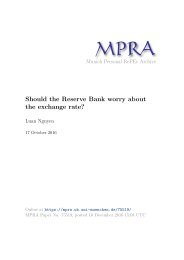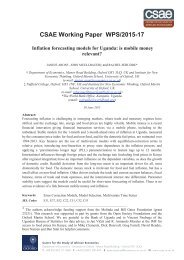debtequity
n?u=RePEc:red:sed016:1511&r=cba
n?u=RePEc:red:sed016:1511&r=cba
Create successful ePaper yourself
Turn your PDF publications into a flip-book with our unique Google optimized e-Paper software.
to have exogenously given expenditure (G) that the fiscal authority finances by issuing bonds B at<br />
date 0 for the value B = G, imposing taxes on investors at date 1 to pay for the government debt.<br />
It also insures banks’ deposits, imposing an insurance premium π per dollar of debt due due at<br />
date 1, and reimburses depositors when banks go bankrupt. The insurance premium decreases the<br />
taxes that taxpayers have to pay when banks are not bankrupt, while reimbursing the depositors<br />
in low realizations of ã requires additional taxes. The Central Bank fixes the interest rate R B<br />
on government bonds and the minimum equity requirement α for banks. If the cash funds are<br />
reimbursed at date 1 when banks are bankrupt, taxes are increased to cover the cost. The taxes<br />
imposed at date 1 in outcome a are thus given by<br />
⎧<br />
⎨R B B − π(R d d + R c c b ), if a ≥ â,<br />
t(a) =<br />
(7)<br />
⎩<br />
R B B + (1 + µ)R d d + R c c b − (1 − γ)Ka, if a ≤ â.<br />
where 1−γ is the recovery rate on output when there is bankruptcy. We could introduce a separate<br />
group of agents who pay taxes (when t(a) > 0) or receive payments (when t(a) < 0). However it is<br />
simpler to assume directly that these taxes are paid by the investors who have sufficient resources<br />
w i1 > 0 to pay for them at date 1.<br />
Assumptions We introduce assumptions on agents’ endowments which ensure that there exist<br />
equilibria with positive debt and equity for banks. In this model with constant returns in technology<br />
and linear date 1 preferences, there is a natural rate of interest R ∗ = E(ã) determined by the<br />
technology which is the expected return at date 1 from a one unit investment of the good at date<br />
0. This is the benchmark interest rate that we use to express the willingness of agents to supply<br />
debt and equity in the economy.<br />
Assumption 1. (a) u ′ i (w i 0) < E(ã);<br />
(b) w i1 > (w d 0 (1 + µ) + w c 0 )E(ã)<br />
Assumption (1)(a) guarantees that investors want to invest in the technology even if the profit<br />
of banks is not increased by leverage, while (b) guarantees that investors have sufficient resources<br />
at date 1 to reimburse the maximum that can be due to depositors and cash funds.<br />
In keeping with the recent literature on shadow banking which emphasizes the magnitude of the<br />
funds on the wholesale money market seeking a safe haven, we assume that (short-term) government<br />
bonds do not absorb all funds that cash funds are willing to lend.<br />
Assumption 2. u ′ c(w c 0 − B) < E(ã)<br />
Under this assumption, for all interest rates R B such that u ′ c(w c 0 − B) < R B ≤ E(ã), the cash<br />
funds want to lend an amount which exceeds the supply of (short-term) government bonds B.<br />
17





